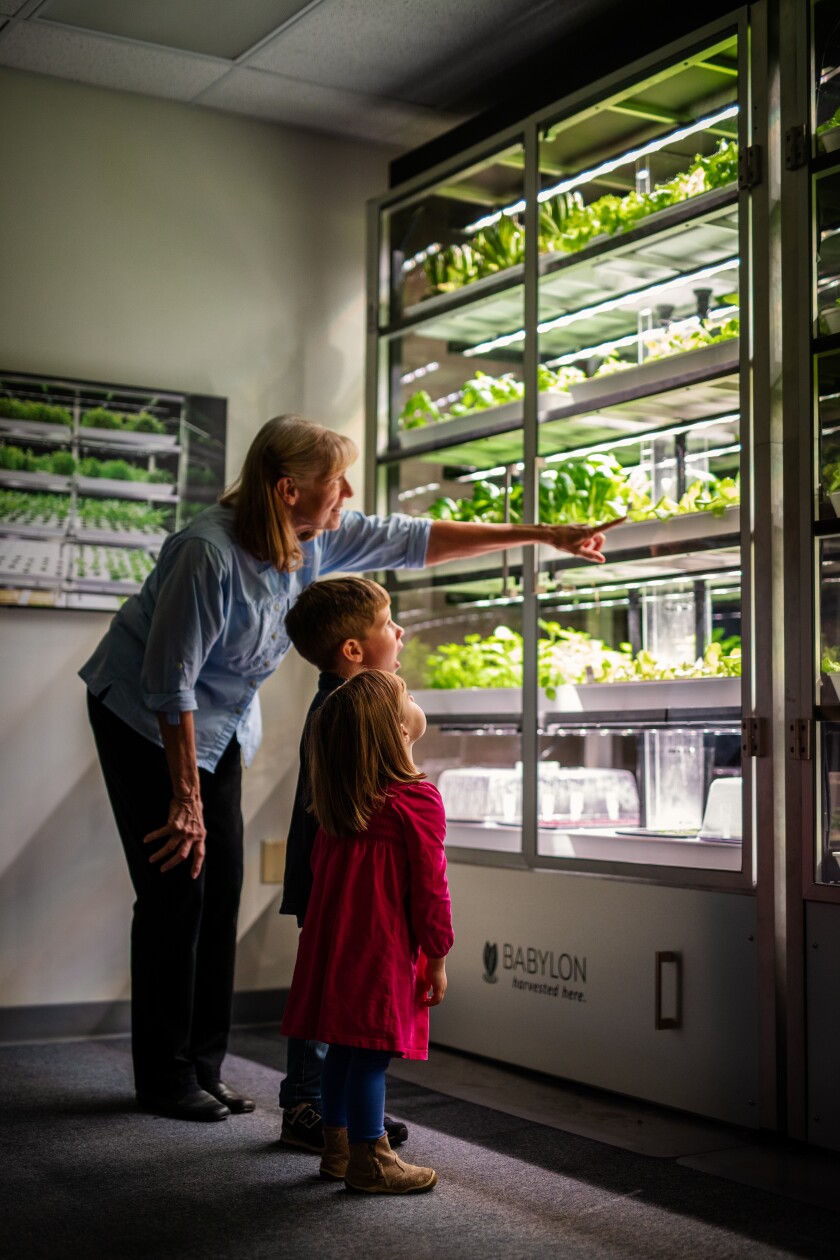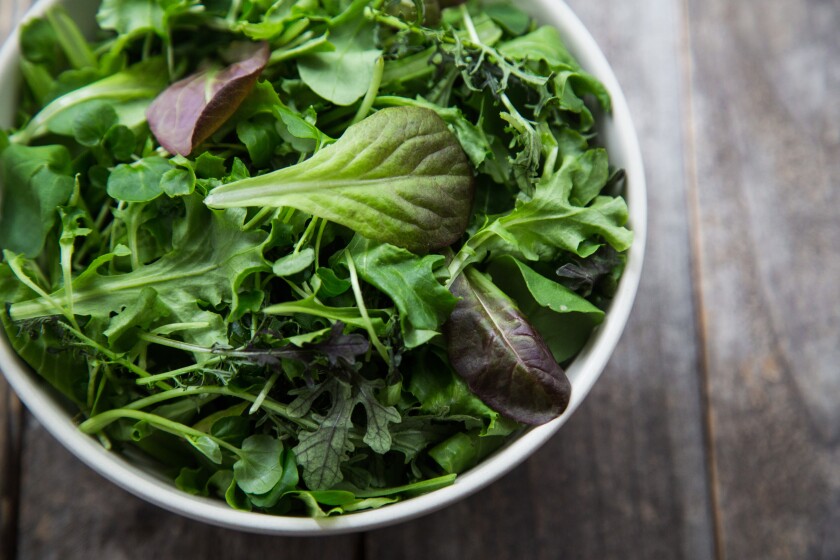
Imagine kale that doesn’t taste like a punishment for something you did in a previous life. Envision leafy greens that aren’t limp from their journey to your plate. Anticipate the intense flavor of just-picked herbs that kick up your latest culinary creation a notch or three.
Then consider the possibility that such advancements will play a role in altering the face of agriculture, becoming sources of flavorful, fresh produce in “food deserts” and making farm-to-table restaurant cuisine possible because produce is grown on the premises, even in urban areas.
This is the potential and the promise of hydroponics (a term that also includes aeroponics and aquaponics systems), the soil-less cultivation of crops in controlled environments. It’s a growing industry — $9.5 billion in sales is expected to nearly double in the next five years — that stems, in part, from concerns about growing enough food to feed a worldwide population expected to hit 10 billion in the next 30 years.
The growing method isn’t new. The Hanging Gardens of Babylon, dating to the 6th century B.C., may be a precursor to today’s hydroponics, if they existed. (Historians disagree on that as well as where the gardens were.) Then, as now, technology is a key to giving growers, not Mother Nature, more control over production.
The size of today’s systems varies. They might be as simple and compact as an in-home system that’s about the size of a couple of loaves of bread stacked on top of each other. Some of the growing popularity of those units may be connected to the pandemic, according to Paul Rabaut, director of marketing for AeroGarden, which produces systems for in-home crop production.
“As soon as the pandemic was declared in mid-March and the quarantine took effect, we saw immediate growth spikes, unlike anything we’d ever seen before,” he said. Those spikes resulted, he said, from the need for entertainment beyond Netflix and jigsaw puzzles, a desire to minimize trips to the grocery store and the promise of teachable moments for kids now schooled at home.
At the other end of the spectrum are large urban farms. Plenty, for instance, has a South San Francisco hydroponics growing facility where a million plant sites produce crops, some of which are sold through area grocery stores. The company hopes to open a farm in Compton this year that’s expected to be about the size of a big-box store and will grow the equivalent of 700 acres of food.
Plenty scientists, engineers and growers at work in their South San Francisco hydroponics growing facility.
(Plenty)
“It’s a super vibrant community with a rich agricultural history,” Nate Storey, a cofounder of the vertical farming company, said of the Compton facility. “It also happens to be a food desert.
“Americans eat only about 30% of what they should be eating as far as fresh foods,” he said. “We started this company because we realized the world needed more fresh fruits and vegetables.”
As different as hydroponics growing systems are, most have this in common: The plants thrive because of the nutrients they receive and the consistency of the environment and can produce crops of fresh leafy greens and other vegetables, various herbs and sometimes fruits.
Such controlled-environment agriculture is part of the larger trend of urban farms, recognized last year by the May opening of the U.S. Department of Agriculture’s Office of Urban Agriculture and Innovative Production. The farms’ proximity to larger markets means produce can be delivered quickly to consumers, whether they’re grocery shoppers, airline passengers, students or communities in need or restaurants, an industry that has been devastated in the last year.
Today’s micro- and mega-farms have taken on increased importance, partly because of world hunger, which will increase as the population grows.
Add increasing urbanization that is gobbling available agricultural land in many countries, mix in climate change and the scramble for water to grow crops — as much as 70% of the world’s water is used for agriculture — and the planet may be at a tipping point.
No single change in the approach to feeding the world will shift the balance by itself.
Hydroponic farming is “a solution,” said Alexander Olesen, a cofounder of Babylon Microfarms in Virginia, which uses its small growing units to help corporate cafeterias, senior living centers, hotels and resorts provide fresh produce, “but they are not the solution.”
Babylon Microfarms in Virginia provides fresh produce for corporate cafeterias, senior living centers, hotels and resorts.
(Babylon Micro-Farms Inc.)
For one thing, not all crops are viable. Nearly everything can be grown using hydroponics but some crops, such as wheat, some root vegetables (including carrots, beets and onions), and melons and vining crops, are impractical. The easiest crops to grow: leafy greens, including spinach and lettuce; microgreens; herbs such as basil, cilantro, oregano and marjoram; some vegetables, such as green peppers and cucumbers; and certain fruits, including tomatoes and strawberries.
Although hydroponic farming means crops grow faster — thus increasing output — the process comes with a significant carbon footprint, according to “The Promise of Urban Agriculture,” a report by the Department of Agriculture/Agricultural Marketing Service and Cornell University Small Farms Program. Lights generate heat, which then must be removed by cooling. Lettuce grown in traditional greenhouses is far cheaper, the report says.
If these crops can be grown traditionally — in a garden or in a commercial field — why bother with growing systems that are less intuitive than planting seeds, watering and harvesting? Among the reasons:
Climate control: Such indoor agriculture generally means consistent light, temperatures, nutrients and moisture for crops no longer held hostage by nature’s cycles of drought, storms and seasons.
Environmental friendliness: Pesticides generally aren’t used and thus create no harmful runoff, unlike field-grown crops.
Productivity: Leafy greens tend to be cool-season crops, but in a controlled environment, it’s an any-time-of-year crop without the worry of depleting the soil because of overuse because, of course, there is no soil.
Use of space: AeroFarms, a former steel mill in Newark, N.J., boasts that it can produce 2 million pounds of food each year in its 70,000 square feet, or about 1.3 acres. California’s Monterey County, by contrast, uses nearly 59,000 acres — out of 24.3 million acres statewide of ranches and farms — to grow its No. 1 crop, which is leaf lettuce valued at $840.6 million, its 2019 crop report showed.
AeroFarms in Newark, N.J. boasts it can produce 2 million pounds of food each year at its 70,000-square-foot facility in Newark, N.J.
(AeroFarms)
Food safety: In E. coli outbreaks in late October and early November of last year, fingers pointed to romaine lettuce that sickened consumers in 19 states, including California. In November and December of 2019, three other outbreaks of the bacterial illness were traced to California’s Salinas Valley. A Food and Drug Administration study, released in May with results from that trio of outbreaks, “suggest(s) that a potential contributing factor has been the proximity of cattle,” whose feces often contain the bacteria and can find its way into water systems.
That’s less of an issue with crops in controlled-environment agriculture, said Alex Tyink, president of Fork Farms of Green Bay, Wis., which produces growing systems suitable for homes and schools.
“In the field, you can’t control what goes where,” he said, including wildlife, livestock or even birds that may find their way into an open growing area.
And as for workers, “The human safety approaches that we take [with] people in our farm make it hard for them to contaminate even if they wanted to,” he said.
“Before people walk in, they gown up, put their hair in nets, beards in nets, put on eye covering and bootie covers for their shoes, then walk through a water bath.”
::
None of the statistics matter, though, unless the quality of soil-less crops matches or exceeds that produced traditionally.
Not a contest, new-age growers say. Flavors of leafy greens, for example, tend to be more detectable and, in some cases, more intense.
So much so that when AeroFarms introduced its baby kale in a New York grocery store, Marc Oshima, a cofounder and chief marketing officer, says he saw a woman do what he called a “happy dance” when she sampled this superfood. The version that AeroFarms produces is lighter and has a “sweet finish,” Oshima said, compared with adult kale grown in traditional ways that some say make the superfood fibrous and bitter.
Storey, the cofounder of Plenty, judged his Crispy Lettuce mix successful when his children got into a “rolling-on-the-floor fistfight” over a package of it.
Some credit for that flavor can be attributed to the time from harvest to market. Arizona and California are the top lettuce producers in the U.S., but by the time the greens get to other parts of the country, they have lost some of their oomph. AeroFarms and Plenty, for instance, distribute their commercial products to nearby grocery stores in New York and the Bay Area, respectively, where their time to market is significantly reduced.
And when was the last time you had a salad on an airplane flight that didn’t taste like water gone bad? Before the pandemic constricted airline traffic, AeroFarms was growing greens to be served to passengers on Singapore Airlines flights from New York’s JFK. The fresh vegetables traveled just five miles from the warehouse to Singapore’s catering kitchen, a new twist on farm to (tray) tabletop.
Because the turnaround from harvest to market is shorter, Storey said his products often last several weeks when refrigerated.
Leafy green vegetables grown by AeroFarms.
(Emily Hawkes)
And perhaps best of all? Growers say that because the greens have a flavor — some peppery, some like mustard — salad dressing may be optional, perhaps dispossessed in favor of the flavor of naked greens.
Getting consumers interested in vegetables and incorporating those foods into their diets is especially important, growers say, because of skyrocketing rates of obesity, diabetes and heart disease, especially for populations in food deserts.
Tyink grew up in rural Wisconsin but moved to New York to pursue a career in opera. By chance, he sampled some produce from a rooftop garden that he called life-altering. “My eating habits changed because [the greens] changed my emotional connection to food,” he said.
His exposure to homelessness and poverty on the streets of New York also focused his attention on what people consume and why. Price and convenience often drive bad food decisions and unhealthy habits.
Young farmers in training can help change those habits; some of Fork Farms’ systems are used in schools and other nonprofit organizations for children. Kids become accidental ambassadors for the nutrient-rich crops, and the fruits of their labors go to school cafeterias or to local food distribution centers in their communities.
“I really think when you lose fresh, locally produced food, you lose something of [the] culture,” said Lee Altier, professor of horticulture at Chico State University, where he has been working with students to develop its aquaponics program. “I think it is so important when communities have an awareness … that this is for their social integrity.”
As for the future, much still needs to be done to put such products in the right hands at the right time. That requires investment, innovation and technology to perfect the systems and keep costs under control, never mind persuading buyers and consumers that food that’s healthy can also be satisfying.
Is it a puzzle worth solving? Storey thinks so. “I want to live in a world where [we create] delicious, amazing things,” he said, “knowing that they are not coming at a cost that we don’t want to pay.”




